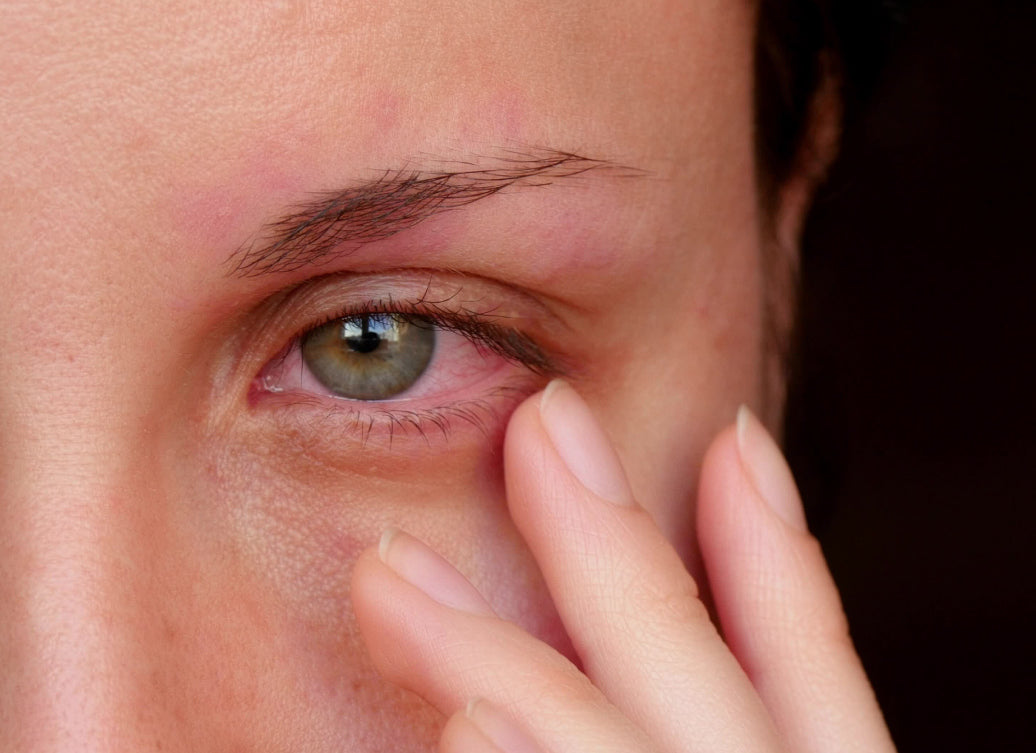In this blog we consider the connection between blepharitis and autoimmunity.
What is blepharitis?
Blepharitis is a condition of the eye that results in itchy, red, watery eyes. It involves the inflammation of the eyelids, with blockages of the oil-producing glands on the eyelid or irritation of the skin at the root of the eyelashes. Although it’s a common condition and is usually fairly mild, it can cause more serious problems if left untreated.
Blepharitis isn’t contagious, and tends to come in waves, with those prone to the condition likely to get it over and over again. As a chronic condition, it can’t be cured, though it can be well managed with a careful daily hygiene routine.
Who gets blepharitis?
Blepharitis is a complex condition with many possible causes, rather than one simple explanation. Although the most common reason given for a flare-up is an overproliferation of microbes (such as bacteria, yeasts or mites) on the skin of the eyelid, this overgrowth is usually associated with various other risk factors.
Risk factors include:
Overall health
Older people are more at risk, as are those who have an existing chronic skin condition like rosacea or seborrheic dermatitis/dandruff. People with diabetes, allergies and autoimmune diseases are also more at risk of blepharitis. There is a connection between infections and blepharitis: it can follow an infection of molluscum, cold sores, or staph.
Psychological well-being
Stress and anxiety seem to aggravate or trigger blepharitis.
Environment
Some environmental factors are likely to aggravate or trigger a blepharitis flare: windy, cold or dry weather; working in an air conditioned space; being in contact with airborne allergens and irritants such as pollution, pollen, car exhaust.
Irritants
Skin contact with irritants such as toiletries, mascara, eyeliner and foundation can also increase the likelihood of getting blepharitis. Wearing contact lenses can also irritate the eyelids.
What’s the connection with auto-immune disease?
Because blepharitis is such a tricky condition to pin down (even if a relatively simple one to manage), it can be hard to work out what’s causing it. In the case of autoimmunity, there’s more of an association than a direct cause and effect; blepharitis certainly seems to have a connection with some autoimmune diseases, even if it is not itself such a condition.
Sjogren's Syndrome
This is an immune disorder that affects the mucous membranes of the mouth and the tear ducts of the eyes, and has blepharitis as one of its symptoms. Sjogren's syndrome often accompanies other immune system disorders, such as rheumatoid arthritis and lupus.
Chronic skin conditions
Rosacea & seborrheic dermatitis are both chronic inflammatory skin conditions which are risk factors for blepharitis. Some would say that skin conditions like eczema, psoriasis and rosacea are themselves autoimmune diseases, rather than associated with them. (People with rheumatoid arthritis and lupus are at increased risk of having a chronic skin condition, like psoriasis.)
In conclusion, blepharitis is not an autoimmune disease.
It is associated with autoimmune diseases, and some autoimmune diseases do affect the eyes, mimicking the symptoms of blepharitis, but it is not itself autoimmune in nature.
Managing blepharitis
Blepharitis responds very well to a daily management plan, which involves a three-step cleaning routine.
- Heat: place a hot compress or eye bag over your eyes for five minutes to warm the area
- Massage: massage very gently around the eyelashes to dislodge crusts and unblock ducts
- Cleaning: use a fresh, clean cotton bud dipped in well-diluted and unscented natural shampoo to clean the area around the eyelashes and eyelids
There’s strong evidence to suggest that 5% tea tree ointment can prevent mites from breeding; massage a small amount of Balmonds Tea Tree Balm into your eyelashes. You can use diluted Balmonds Natural Shampoo & Body Wash to clean the area.
As part of your daily cleansing routine, swap your foaming or scented make-up remover for an oil-based cleanser, like Balmonds Omega-Rich Cleansing Oil, which is much less likely to irritate your eyelids.
If the condition persists, doesn’t improve or gets worse after a week of this regime, consult a doctor or pharmacist; you may be prescribed antibiotic eye drops.
Recommended products:
Balmonds Skin Salvation
with hemp and beeswax
Balmonds Tea Tree Balm
balm with tea tree essential oil and beeswax
Balmonds Natural Shampoo & Body Wash
with calendula & chamomile
Balmonds Omega-Rich Cleansing Oil
with rosehip and calendula
